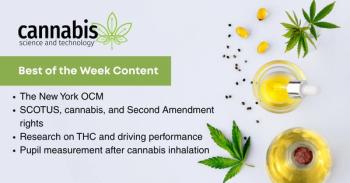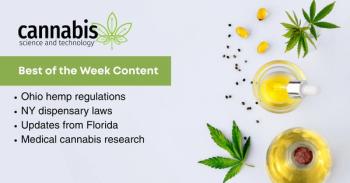
Cannabis Science and Technology
- October 2020
- Volume 3
- Issue 8
THC Remediation: A Basic Understanding

Ric Cuchetto discusses the technology behind THC remediation and some of the challenges it presents.
Tetrahydrocannabinol (THC) remediation can be defined as any process that removes or reduces the level of the THC cannabinoid from hemp-derived products and extracts. We recently spoke with Ric Cuchetto, The Cannabis ChemistTM, to learn more about the technology behind THC remediation and some of the challenges it presents.
Can you tell us about your role in the cannabis industry?
Ric Cuchetto: My background is in analytical chemistry, especially chromatography. I started taking what I knew from analytical scale and doing preparative scale separations. The first experiments involved cutting the lesser percentages of cannabidiol (CBD) out of tetrahydrocannabinol (THC) extracts to make 1:1 tinctures. Then “Charlotte’s Web” came out and CBD varietals exploded. There was zero reason to use techniques such as chromatography. We could create any ratio of CBD:THC medicines desired without expensive and tedious molecular separations.
I still used flash chromatography to remove delta-9 THC selectively to create anti-inflammatory formulations that had low intoxication. My spouse has a rare disease that causes traumatic brain injury. Her symptoms are alleviated with certain cannabis formulations.
I helped formulate the initial regulations for pesticides analysis in commercial cannabis. Most of my current work involves refining marginal botanical oils into premium products.
What is THC remediation and how does your work relate to it?
Cuchetto: THC remediation is any process that reduces THC concentrations in order to comply with regulatory or quality objectives. Dilution is one solution.
What technologies or methods work best for THC remediation?
Cuchetto: Certainly, that is the grand debate. What works best for what THC level input? What works best for what final THC level? What works best at what scale? What is the skill level of operators? Is this project CapEx or OpEx intensive? I often combine technologies to provide the best solutions for my clients.
Dilution is the low-tech winner, often hemp seed oil or mid-chain triglycerides (MCT), such as palm oil, are used to bring THC levels within regulatory compliance.
Crystallization is the most common method. After “decarboxylation” (heating to convert CBDA to CBD), CBD crystallizes easily. Crystallization also does a great job of pesticide remediation.
Flash chromatography was my original introduction to THC remediation and still a major tool for me. This process utilizes specialty polymeric resins and large solvent volumes. Supercritical fluid chromatography is emerging as a subset of flash operations. Significant solvent reductions are possible compared to conventional systems.
There are other techniques as well, such as molecular imprinted polymer (MIPs) technology. MIPs uses polymeric resins with specificity for cannabinoid molecules.
These technologies retain THC or THCA molecules with weak attractions in the resins. Other technologies use solvents to preferentially extract the acid (THCA, CBDA) or neutral forms (THC, CBD) of the cannabinoids.
Lastly, some technologies use precise fractional distillation to separate THC from CBD.
Does THC remediation pose any challenges? If so, do you have advice or tips on how to address those challenges?
Cuchetto: Generally, challenges increase with decreasing concentration. In Colombia, the THC limit is 1%. In the US, Congress set the limit to 0.3% THC for hemp-derived products. For many EU clients, we need less than 0.05%. We go back to the primary questions of what is the input volume and THC concentration? What is the maximum allowable output THC concentration?
Also, what happens for the analytical testing? Can you ship products with more than 0.3% THC by USPS, UPS, or FedEx? The laws vary by state for how the analytical can be performed. The Food and Drug Administration (FDA) certainly seems to be an influencer if not an enforcer right now.
What kind of end-products are created using THC remediation?
Cuchetto: The most basic level product is “isolate;” CBD crystal >99.5%. There are distillates in the 80% to 95+% cannabinoid content. Crude extracts often contain 30–50% active ingredient. After “winterization,” crude oils can have 50–75% cannabinoids. Other “bioactives” (such as terpenes) add to the “spectrum.” Crude oils that have been winterized and THC remediated would be a “broad spectrum” oil.
Any of these oils can be converted to other form factors such as nano-emulsions, water soluble powders, and so forth.
Has the legalization of hemp increased the focus or desire for THC remediation?
Cuchetto: The legalization of hemp unleashed my favorite mission statement: “sempre mas grande,” which roughly translates to always bigger. With thousands of acres of fields growing biomass that doesn’t meet regulatory requirements once it is extracted, that makes for a large audience. Hemp growing is a math problem. Even if the cultivar has only 0.2% THC in the field, once it is extracted into an oil form, it will be above the regulatory limit (“hot”). Conventional distillation does not separate THC from CBD. In fact, it will produce even higher THC levels. For the main cultivar that I work with, 0.8% THC in flower becomes about 3.5% in crude extracts and about 5.5% in distillate.
Are there any other factors in the industry that might play a role in increased demand for THC remediation?
Cuchetto: I think just the greater acceptance of cannabinoids as therapeutic is exponential.
Do you foresee any other cannabinoids coming into play for THC remediation in the future? For example, do you think there might be a demand for cannabigerol (CBG)-only products?
Cuchetto: Absolutely. A few of the manufacturers already do CBG-only production. As long as THC continues to be a Schedule I listing, any of the other molecules in this amazing botanical will need to have non-detectable levels of THC to appeal to the broadest markets.
My primary focus is on molecular isolations. As we gain more understanding of the potential in the components of this plant, I expect to continue to provide these materials to the botanical supplement market.
How to Cite this Article
M. L’Heureux, Cannabis Science and Technology 3(8), 38-39 (2020).
Articles in this issue
about 5 years ago
The FDA is Coming…Will the Cannabis Industry Be Ready? Part Iabout 5 years ago
Cannabis Cultivation: The New Agriculture Tech Playgroundabout 5 years ago
Integrated Data in Cannabis ERP: From Greenhouse to Productionabout 5 years ago
How to Rein in Cannabis Industry Energy?Newsletter
Unlock the latest breakthroughs in cannabis science—subscribe now to get expert insights, research, and industry updates delivered to your inbox.





